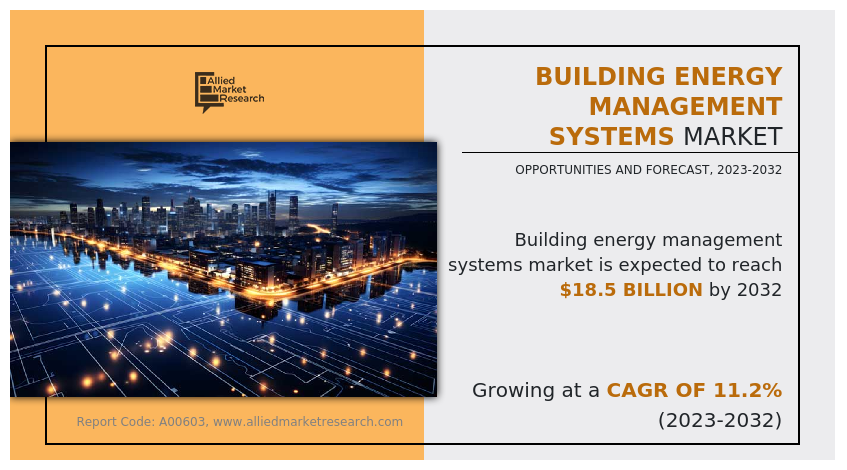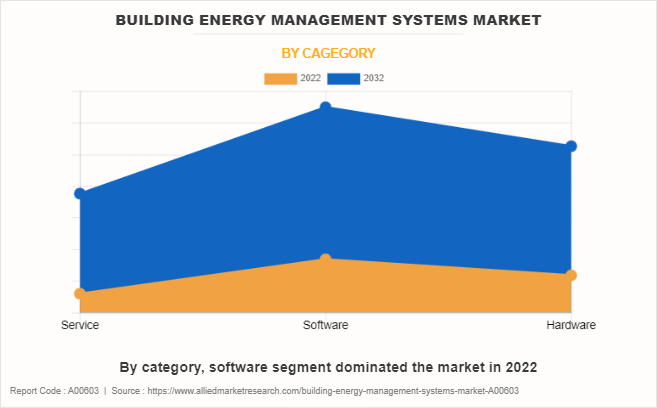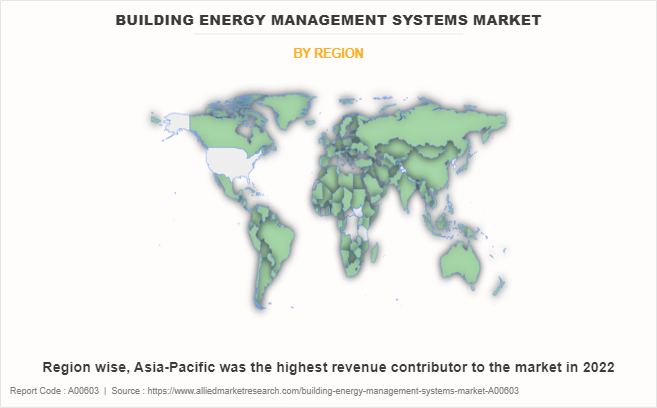Building Energy Management Systems Market Research, 2032
The global building energy management systems market size was valued at $6.5 billion in 2022, and is projected to reach $18.5 billion by 2032, growing at a CAGR of 11.2% from 2023 to 2032.
Report Key Highlighters:
- The Building Energy Management Systems Industry covers 20 countries. The research includes a segment analysis of each country in terms of value ($million) for the projected period 2023-2032.
- The study integrated high-quality data, professional opinions and analysis, and critical independent perspectives. The research approach is intended to provide a balanced view of global building energy management system market and to assist stakeholders in making educated decisions in order to achieve their most ambitious growth objectives.
- Over 3,700 product literature, annual reports, industry statements, and other comparable materials from major industry participants were reviewed to gain a better understanding of the building energy management systems market growth.
- The Building Energy Management Systems Market Share is highly fragmented, with several players including ABB Group, Accruent Inc., Azbil Corporation, Daikin Applied, Acuity Brands Lighting Inc., DEXMA, Albireo Energy LLC, Airedale International Air Conditioning Ltd., IBM Corporation, and Emerson Electric Co. Also tracked key strategies such as acquisitions, product launches, mergers, expansion etc. of the players operating in the building energy management systems market statistics.

Building Energy Management Systems (BEMS) play a crucial role in current construction and facility management, providing complete solutions for optimizing power consumption and enhancing operational efficiency. The ability to display and manage constructing systems remotely is a enormous factor in the growth of BEMS. This feature allows for real-time changes and proactive management of power consumption.
Building Energy Management System (BEMS) is a comprehensive strategy to monitor, control, and optimize power consumption in industrial and residential buildings. This system integrates hardware, software, and offerings to enhance power efficiency, limit operational costs, and limit environmental impact.
BEMS involves the deployment of sensors, meters, and control systems to accumulate real-time facts on electricity utilization inside a building. This data is then analyzed to discover patterns, inefficiencies, and opportunities for improvement. The device also enables automatic manage of various building components, such as heating, ventilation, air conditioning (HVAC), lighting, and different systems that make contributions to common energy consumption.
BEMS offers a granular understanding of energy usage patterns, allowing for focused interventions to optimize consumption. This leads to substantial price savings by decreasing electricity waste and improving ordinary operational efficiency. Additionally, BEMS allows compliance with environmental guidelines and sustainability goals, contributing to a greener and more accountable approach to constructing management.
Technological developments play a pivotal role in the developing reputation of building energy management system market. The development of sophisticated sensors, communication protocols, and records analytics equipment has empowered BEMS to supply more accurate and actionable insights. Cloud computing and the Internet of Things (IoT) have further enhanced the competencies of BEMS by enabling remote monitoring and control, making it easier for customers to access real-time data and implement changes as needed.
Commercial buildings, inclusive of offices, purchasing malls, and hotels, leverage BEMS to make sure top of the line comfort for occupants while minimizing energy waste. In the industrial sector, BEMS contributes to environment friendly manufacturing processes by optimizing the use of energy-intensive equipment. In residential buildings, house owners can use BEMS to manage heating, cooling, and lighting fixtures structures for better electricity efficiency.
The constructing is equipped with sensors and meters strategically positioned to acquire facts on distinctive factors like temperature, humidity, occupancy, and strength usage. These sensors enable real-time monitoring, allowing the system to regulate to dynamic conditions and optimize electricity consumption. For example, temperature sensors alter heating, ventilation and air conditioning (HVAC) structures based on elements such as occupancy and external climate conditions, ensuring comfort while minimizing electricity wastage.
The consumer interface performs a essential role in Building Energy Management Systems (BEMS), offering constructing managers and occupants a visual overview of power utilization and device performance. Utilizing an intuitive dashboard, users can preserve track of power consumption, personalize preferences, and receive indicators or pointers for energy-efficient actions. This transparency and ease of use empower customers to actively engage in efforts to conserve energy.
Government initiatives promoting energy effectivity and sustainability, coupled with the rising focus of company social responsibility, are driving corporations to make investments in BEMS. The potential of BEMS to contribute to green constructing certifications, such as LEED (Leadership in Energy and Environmental Design), similarly incentivizes its adoption in the building and real property industries.
The integration of renewable power sources is a growing trend in BEMS implementation. By incorporating solar panels, wind turbines, or different renewable sources, constructions can generate their own energy, decreasing reliance on normal energy grids. BEMS plays a essential function in managing the integration of renewable energy, balancing manufacturing and consumption for maximum efficiency.
The environmental advantages of BEMS extend to the reduction of carbon emissions. By optimizing strength use and facilitating the integration of renewable electricity sources, BEMS supports sustainability goals and helps organizations minimize their carbon footprint.
Rise In IoT, Cloud Computing, To Enhance Building Energy Management Systems (BEMS)
The integration of the Internet of Things (IoT), cloud computing, and Building Energy Management Systems (BEMS) has become a pivotal trend in the field of smart constructions and sustainable energy management. The proliferation of data from IoT devices within constructions generates enormous quantities of information associated to energy consumption, occupancy patterns, and equipment performance. Cloud computing provides the vital infrastructure for storing and processing this large extent of data. Advanced analytics powered by cloud systems allow actionable insights, allowing BEMS to make informed selections for optimizing power usage and resource allocation.
In November 2022, View Inc. launched the View Partner Marketplace, an app store for users of their Smart Building Cloud. This cloud-native platform enables handy deployment of real estate applications, software, and sensors with a single click, streamlining the digitization of constructing portfolios for owners and operators.
Complexity In Building Energy Management System Customization Expected To Restraint The Market
Customizing a BEMS involves the series and evaluation of sensitive records associated to a building's energy consumption. Ensuring the safety and privacy of this information is a crucial constraint. Compliance with facts protection regulations and imposing robust cybersecurity measures becomes essential. Failure to address these issues can also lead to legal ramifications and damage the reputation of the organization.
The customization of BEMS regularly requires a substantial financial investment. Small and medium-sized enterprises, in particular, may additionally face budgetary constraints that restrict their ability to implement advanced power administration solutions. Striking a balance between cost-effective customization and superior device performance is a substantial task for corporations with limited financial resources.
The building energy management systems market is segmented into category, end-use industry, and region. On the basis of category, the market is classified into service, software, and hardware. On the basis of the end-use industry, the market is divided into residential, commercial & institutional, and industrial. Region-wise, the market is studied across North America, Europe, Asia-Pacific, and LAMEA.

On the basis of category software segment dominated the building energy management systems market accounted for one third of the market share in 2022. BEMS software analyzes the collected data to identify patterns, trends, and anomalies in energy usage. Users can generate reports and visualizations to understand the building's energy performance, allowing for informed decision-making. Automated adjustments to HVAC systems, lighting, and other equipment help maintain comfort levels while minimizing energy waste.

Based on end-user industry residential segment dominated the building energy management systems market accounted for one third of the market share growing with the CAGR of 11.0% in 2022. Home energy management system (HEMS) allows homeowners to monitor their energy consumption in real-time. Analytics tools provide insights into energy usage patterns, helping residents identify areas where energy can be conserved. HEMS can manage smart lighting systems, adjusting brightness levels and turning off lights in unoccupied rooms. Integration with natural light sensors can further optimize lighting based on daylight availability.

Region wise Asia-Pacific dominated the building energy management systems market growing with the CAGR of 11.6% to the market. Many countries in the Asia-Pacific region are experiencing rapid economic growth, urbanization, and increased energy consumption. This has led to heightened concerns about energy security and environmental sustainability. Singapore is at the forefront of smart city development in the Asia-Pacific. The government has implemented the Smart Nation initiative, which includes the use of BEMS to optimize energy consumption in buildings. The integration of BEMS with smart technologies is a key aspect of Singapore's sustainable urban planning.
The major players operating in the building energy management market include ABB Group, Accruent Inc., Azbil Corporation, Daikin Applied, Acuity Brands Lighting Inc., DEXMA, Albireo Energy LLC, Airedale International Air Conditioning Ltd., IBM Corporation, and Emerson Electric Co.
Apart from the above-listed companies, there are many manufacturers of building energy management system including Distech Controls, Automated Logic Corporation, Ecova, GridPoint, Echelon Corporation, Lucid, Elster Group, Daintree Networks, Danfoss, Legrand, Carrier, Osram, GE Digital, Iconics, Tridium, KMC Controls, Ameresco and others).
Historic Trends of Building Energy Management System Market
- In the 1970s, the energy crisis caused a heightened emphasis on energy efficiency. This era saw the advent of initial building automation systems, precursors to Building Energy Management Systems (BEMS). These early structures targeted on regulating Heating, Ventilation, and Air Conditioning (HVAC) systems, representing a essential milestone in the evolution of holistic constructing electricity management.
- By the 1990s, substantial developments occurred, with the integration of lighting, security, and HVAC structures into unified management. Microprocessor technology became more widely available, enabling more sophisticated control systems.
- In the 2000s, the emergence of open-source requirements improved interoperability, enabling seamless communication between devices from various producers inside Building Energy Management Systems (BEMS). Concurrently, developments in sensor technology and facts analytics played a vital role in making BEMS more intelligent and responsive, optimizing strength administration and operational efficiency.
- In the 2010s, Building Energy Management Systems (BEMS) saw massive advancements with the integration of cloud computing and IoT, enabling remote monitoring and control. This decade also witnessed the incorporation of energy analytics and machine learning into BEMS for purposes like predictive maintenance and optimization, enhancing overall efficiency and performance.
Key Benefits For Stakeholders
- This report provides a quantitative analysis of the market segments, buildinge energy management system market trends, estimations, and dynamics of the building energy management systems market analysis from 2022 to 2032 to identify the prevailing building energy management systems market opportunities.
- The market research is offered along with information related to key drivers, restraints, and opportunities.
- Porter's five forces analysis highlights the potency of buyers and suppliers to enable stakeholders make profit-oriented business decisions and strengthen their supplier-buyer network.
- In-depth analysis of the building energy management systems market forecast assists to determine the prevailing building energy management system market opportunities.
- Major countries in each region are mapped according to their revenue contribution to the global building energy management system market statistics.
- Market player positioning facilitates benchmarking and provides a clear understanding of the present position of the market players.
- The report includes the building energy management system market analysis of the regional as well as global building energy management systems market trends, key players, market segments, application areas, and market growth strategies.
Building Energy Management Systems Market Report Highlights
| Aspects | Details |
| Market Size By 2032 | USD 18.5 billion |
| Growth Rate | CAGR of 11.2% |
| Forecast period | 2022 - 2032 |
| Report Pages | 270 |
| By Category |
|
| By End-User |
|
| By Region |
|
| Key Market Players | IBM Corporation, ABB Group, Acuity Brands Lighting Inc., Dexma, Accruent Inc., Azbil Corporation, Albireo Energy LLC, Daikin Applied, Airedale International Air Conditioning Ltd., Emerson Electric Co. |
Analyst Review
According to the opinions of various CXOs of leading companies, the global building energy management system market was dominated by the software segment. The integration of BEMS into software platforms has unlocked new possibilities for real-time monitoring and control. Software-based BEMS solutions offer a centralized approach, allowing users to access and manage building systems through user-friendly interfaces. This integration enhances flexibility, scalability, and accessibility, making it easier for organizations to implement and maintain energy-efficient practices.
Integration of IoT, cloud computing, and enhances building energy management systems (BEMS) capabilities. The proliferation of data from IoT devices within buildings generates vast amounts of information related to energy consumption, occupancy patterns, and equipment performance. Cloud computing provides the necessary infrastructure for storing and processing this massive volume of data. Advanced analytics powered by cloud platforms enable actionable insights, allowing BEMS to make informed decisions for optimizing energy usage and resource allocation.
However, complexity in building energy management system customization expected to restraint the market. BEMS customization demands expertise in both building systems and data analytics. The shortage of skilled personnel with a deep understanding of energy management, data science, and building automation poses a significant restraint. Organizations may struggle to find qualified professionals capable of designing, implementing, and maintaining a customized BEMS.
The Asia-Pacific region is projected to register robust growth during the forecast period. The Building Energy Management System market in Asia-Pacific is poised for continued growth, driven by government initiatives, rising energy costs, and an increasing focus on sustainability. As technology continues to advance and awareness of energy-efficient practices grows, BEMS will play a pivotal role in shaping the future of smart and sustainable buildings across the region.
The global building energy management system market was valued at $6.5 billion in 2022, and is projected to reach $18.5 billion by 2032, growing at a CAGR of 11.2% from 2023 to 2032.
The building energy management systems market is segmented into category, end-use industry, and region. On the basis of category, the market is classified into service, software, and hardware. On the basis of the end-use industry, the market is divided into residential, commercial & institutional, and industrial. Region-wise, the market is studied across North America, Europe, Asia-Pacific, and LAMEA.
Asia-Pacific is the largest regional market for building energy management systems.
The increasing trend toward smart buildings and smart cities are the upcoming trends of building energy management systems market in the world.
Residential is the leading application of building energy management systems market.
Rise in IoT, cloud computing, and enhance building energy management systems (BEMS) is the driving factor of the market.
The the top companies to hold the market share in building energy management systems ABB Group, Accruent Inc., Azbil Corporation, Daikin Applied, Acuity Brands Lighting Inc., DEXMA, Albireo Energy LLC, Airedale International Air Conditioning Ltd., IBM Corporation, and Emerson Electric Co.
Loading Table Of Content...
Loading Research Methodology...



